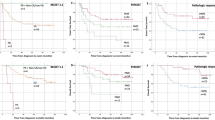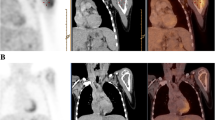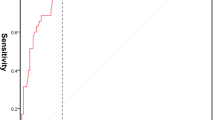Abstract
Purpose
The objective of this study was to determine whether 18F-fluorodeoxyglucose (FDG) positron emission tomography (PET) can adequately assess the risk of systemic disease progression in patients with primary, localized, high-grade soft tissue sarcomas of the extremities undergoing neoadjuvant isolated limb perfusion (ILP) with tumour necrosis factor and melphalan.
Methods
This was a retrospective analysis of the files of 35 patients who underwent a PET or PET/CT scan prior to and after ILP followed by surgical resection with curative intent between 2006 and 2012. SUVmax1 was defined as the maximum standardized uptake value (SUV) at diagnosis, SUVmax2 as the maximum SUV after ILP and ΔSUVmax as the percentage difference between SUVmax1 and SUVmax2.
Results
The median follow-up was 40 months for all patients. The median SUVmax1 amounted to 7.6, while the median SUVmax2 was 4.7. The median ΔSUVmax was −44 %. Overall survival (OS) probability at 2 and 5 years amounted to 78 and 70 %, respectively, while metastasis-free survival (MFS) probability at 2 and 5 years was 67 and 64 %, respectively. Receiver-operating characteristic (ROC) curve analysis showed that both SUVmax2 and ΔSUVmax could predict systemic disease progression, while SUVmax1 could not adequately identify patients who went on to develop metastatic disease. The optimal cut-off value was 6.9 for SUVmax2 and −31 % for ΔSUVmax. Patients with an SUVmax2 <6.9 had a 2-year MFS of 80 %, compared to 31 % for patients with an SUVmax2 ≥ 6.9 (p < 0.001). Patients with a ΔSUVmax < −31 %, i.e. patients with a higher metabolic response, had an MFS of 76 % at 2 years, compared to 42 % for patients with a ΔSUVmax ≥ −31 % (p = 0.050).
Conclusion
SUVmax after ILP for primary, locally advanced, non-metastatic high-grade soft tissue sarcomas of the extremities appears to be significantly correlated with prognosis. Whether patients with a high SUVmax after ILP will benefit from standard or experimental adjuvant systemic treatment options should be evaluated in future studies.






Similar content being viewed by others
References
Clarkson P, Ferguson PC. Primary multidisciplinary management of extremity soft tissue sarcomas. Curr Treat Options Oncol 2004;5:451–62.
Rosenberg SA, Tepper J, Glatstein E, Costa J, Baker A, Brennan M, et al. The treatment of soft-tissue sarcomas of the extremities: prospective randomized evaluations of (1) limb-sparing surgery plus radiation therapy compared with amputation and (2) the role of adjuvant chemotherapy. Ann Surg 1982;196:305–15.
Andreou D, Fehlberg S, Tiedke C, Niethard M, Tunn PU. Revolutionizing the treatment of locally advanced extremity soft tissue sarcomas: a review on TNFa-based isolated limb perfusion. Eur Surg 2009;41:176–88.
Tunn PU, Kettelhack C, Durr HR. Standardized approach to the treatment of adult soft tissue sarcoma of the extremities. Recent Results Cancer Res 2009;179:211–28.
Benz MR, Allen-Auerbach MS, Eilber FC, Chen HJ, Dry S, Phelps ME, et al. Combined assessment of metabolic and volumetric changes for assessment of tumor response in patients with soft-tissue sarcomas. J Nucl Med 2008;49:1579–84. doi:10.2967/jnumed.108.053694.
Grabellus F, Stylianou E, Umutlu L, Sheu SY, Lehmann N, Taeger G, et al. Size-based clinical response evaluation is insufficient to assess clinical response of sarcomas treated with isolated limb perfusion with TNF-alpha and melphalan. Ann Surg Oncol 2012;19:3375–85. doi:10.1245/s10434-012-2408-1.
Eary JF, Hawkins DS, Rodler ET, Conrad 3rd EU. (18)F-FDG PET in sarcoma treatment response imaging. Am J Nucl Med Mol Imaging 2011;1:47–53.
Schuetze SM, Rubin BP, Vernon C, Hawkins DS, Bruckner JD, Conrad 3rd EU, et al. Use of positron emission tomography in localized extremity soft tissue sarcoma treated with neoadjuvant chemotherapy. Cancer 2005;103:339–48. doi:10.1002/cncr.20769.
Benz MR, Evilevitch V, Allen-Auerbach MS, Eilber FC, Phelps ME, Czernin J, et al. Treatment monitoring by 18F-FDG PET/CT in patients with sarcomas: interobserver variability of quantitative parameters in treatment-induced changes in histopathologically responding and nonresponding tumors. J Nucl Med 2008;49:1038–46. doi:10.2967/jnumed.107.050187.
Evilevitch V, Weber WA, Tap WD, Allen-Auerbach M, Chow K, Nelson SD, et al. Reduction of glucose metabolic activity is more accurate than change in size at predicting histopathologic response to neoadjuvant therapy in high-grade soft-tissue sarcomas. Clin Cancer Res 2008;14:715–20. doi:10.1158/1078-0432.CCR-07-1762.
Herrmann K, Benz MR, Czernin J, Allen-Auerbach MS, Tap WD, Dry SM, et al. 18F-FDG-PET/CT imaging as an early survival predictor in patients with primary high-grade soft tissue sarcomas undergoing neoadjuvant therapy. Clin Cancer Res 2012;18:2024–31. doi:10.1158/1078-0432.CCR-11-2139.
van Ginkel RJ, Hoekstra HJ, Pruim J, Nieweg OE, Molenaar WM, Paans AM, et al. FDG-PET to evaluate response to hyperthermic isolated limb perfusion for locally advanced soft-tissue sarcoma. J Nucl Med 1996;37:984–90.
van Ginkel RJ, Kole AC, Nieweg OE, Molenaar WM, Pruim J, Koops HS, et al. L-[1-11C]-tyrosine PET to evaluate response to hyperthermic isolated limb perfusion for locally advanced soft-tissue sarcoma and skin cancer. J Nucl Med 1999;40:262–7.
Been LB, Suurmeijer AJ, Elsinga PH, Jager PL, van Ginkel RJ, Hoekstra HJ. 18F-fluorodeoxythymidine PET for evaluating the response to hyperthermic isolated limb perfusion for locally advanced soft-tissue sarcomas. J Nucl Med 2007;48:367–72.
Gaston LL, Di Bella C, Slavin J, Hicks RJ, Choong PF. 18F-FDG PET response to neoadjuvant chemotherapy for Ewing sarcoma and osteosarcoma are different. Skeletal Radiol 2011;40:1007–15. doi:10.1007/s00256-011-1096-4.
Beyer T, Antoch G, Müller S, Egelhof T, Freudenberg LS, Debatin J, et al. Acquisition protocol considerations for combined PET/CT imaging. J Nucl Med 2004;45 Suppl 1:25S–35S.
Folpe AL, Lyles RH, Sprouse JT, Conrad 3rd EU, Eary JF. (F-18) fluorodeoxyglucose positron emission tomography as a predictor of pathologic grade and other prognostic variables in bone and soft tissue sarcoma. Clin Cancer Res 2000;6:1279–87.
Eary JF, O’Sullivan F, Powitan Y, Chandhury KR, Vernon C, Bruckner JD, et al. Sarcoma tumor FDG uptake measured by PET and patient outcome: a retrospective analysis. Eur J Nucl Med Mol Imaging 2002;29:1149–54. doi:10.1007/s00259-002-0859-5.
Perkins NJ, Schisterman EF. The inconsistency of “optimal” cutpoints obtained using two criteria based on the receiver operating characteristic curve. Am J Epidemiol 2006;163:670–5. doi:10.1093/aje/kwj063.
Grabellus F, Kraft C, Sheu-Grabellus SY, Bauer S, Podleska LE, Lauenstein TC, et al. Tumor vascularization and histopathologic regression of soft tissue sarcomas treated with isolated limb perfusion with TNF-alpha and melphalan. J Surg Oncol 2011;103:371–9. doi:10.1002/jso.21724.
Kaplan E, Maier P. Nonparametric estimation from incomplete observations. J Am Stat Assoc 1958;53:457–81.
Mantel N. Evaluation of survival data and two new rank order statistics arising in its consideration. Cancer Chemother Rep 1966;50:163–70.
Khanna C, Hunter K. Modeling metastasis in vivo. Carcinogenesis 2005;26:513–23. doi:10.1093/carcin/bgh261.
Demicheli R, Retsky MW, Hrushesky WJ, Baum M, Gukas ID. The effects of surgery on tumor growth: a century of investigations. Ann Oncol 2008;19:1821–8. doi:10.1093/annonc/mdn386.
Huth JF, Mirra JJ, Eilber FR. Assessment of in vivo response to preoperative chemotherapy and radiation therapy as a predictor of survival in patients with soft-tissue sarcoma. Am J Clin Oncol 1985;8:497–503.
Kasper B, Dietrich S, Dimitrakopoulou-Strauss A, Strauss LG, Haberkorn U, Ho AD, et al. Early prediction of therapy outcome in patients with high-risk soft tissue sarcoma using positron emission tomography. Onkologie 2008;31:107–12. doi:10.1159/000113795.
Schwarzbach MH, Hinz U, Dimitrakopoulou-Strauss A, Willeke F, Cardona S, Mechtersheimer G, et al. Prognostic significance of preoperative [18-F] fluorodeoxyglucose (FDG) positron emission tomography (PET) imaging in patients with resectable soft tissue sarcomas. Ann Surg 2005;241:286–94.
Eggermont AM, de Wilt JH, ten Hagen TL. Current uses of isolated limb perfusion in the clinic and a model system for new strategies. Lancet Oncol 2003;4:429–37.
Italiano A, Delva F, Mathoulin-Pelissier S, Le Cesne A, Bonvalot S, Terrier P, et al. Effect of adjuvant chemotherapy on survival in FNCLCC grade 3 soft tissue sarcomas: a multivariate analysis of the French Sarcoma Group Database. Ann Oncol 2010;21:2436–41. doi:10.1093/annonc/mdq238.
ESMO/European Sarcoma Network Working Group. Soft tissue and visceral sarcomas: ESMO Clinical Practice Guidelines for diagnosis, treatment and follow-up. Ann Oncol 2012;23 Suppl 7:vii92–9. doi:10.1093/annonc/mds253.
Woll PJ, Reichardt P, Le Cesne A, Bonvalot S, Azzarelli A, Hoekstra HJ, et al. Adjuvant chemotherapy with doxorubicin, ifosfamide, and lenograstim for resected soft-tissue sarcoma (EORTC 62931): a multicentre randomised controlled trial. Lancet Oncol 2012;13:1045–54. doi:10.1016/S1470-2045(12)70346-7.
Conflicts of interest
None.
Author information
Authors and Affiliations
Corresponding author
Rights and permissions
About this article
Cite this article
Andreou, D., Boldt, H., Pink, D. et al. Prognostic relevance of 18F-FDG PET uptake in patients with locally advanced, extremity soft tissue sarcomas undergoing neoadjuvant isolated limb perfusion with TNF-α and melphalan. Eur J Nucl Med Mol Imaging 41, 1076–1083 (2014). https://doi.org/10.1007/s00259-013-2680-8
Received:
Accepted:
Published:
Issue Date:
DOI: https://doi.org/10.1007/s00259-013-2680-8




